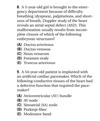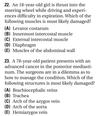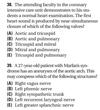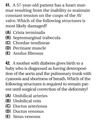[Review Test] Thorax Flashcards
(31 cards)

- 1 C
- 2 A
- 3 C
A 17 year old boy was involved in a gang fight, and a stab wound severed the white rami communicantes at the level of his sixth thoracic vertebra. This injury would result in degeneration of nerve cell bodies in which of the following structurs?
- A. Dorsal root ganglion and anterior horn of the spinal cord
- B. Sympathetic chanin ganglion and dorsal root ganglion
- C. Symapthetic chain ganglion and posterior horn of the spinal cord
- D. Dorsal goot ganglion and lateral horn of the spinal cord
- E. Anterior and lateral horns of the spinal cord
D

- 5 D
- 6 B
- Great cardiac vein : accompanied by the anterior interventricular artery
- Anterior cardiac vein: drains directly into the RA
- Small cardiac vein: accompanied by marginal artery
A 37 year old patient with palpitation was examined by her physcian, and one of the diagnostic records included a posterior-anterior chest radiograph. Which of the following comprises the largest portion of the sternocostal surface of the hear seen on the radiograph
- A. Left atrium
- B. Right Atrium
- C. Left Ventricle
- D. Right Ventricle
- E. Base of the heart
D

- 8 D
- 9 C

- 10 A
- Right middle lobar :medial and lateral bronchopulmonary segment
- Right superior: Superior, psoterior, anterior segmental bronchi
- Right inferior: anterior, lateral, posterior, anterior segmental
- 11 C
An 83 year old man with a typical coronary circulation has been suffering from an embolism of the circumflex brach of the left coronary artery. This condition would result in ischemia of thich of the following areas of the heart:
- A. Anterior part of the LV
- B. Anteriror interventricular region
- C. Posterior Interventricular Region
- D. Posterior part of the ventricle
- E. Anterior part of the right ventricle
D

- 13 C
- 14 D
- The middle, small, and oblique veins drain into the coronary sinus
- Right and Left pulmonoary vein drain into the left atrium
- 15 B
A 75 year old patient has been suffering from lung cancer located near the cardiac notch, a deep indentation of the lung. Which of the following lobes is most likeyly to be excised?
- A. Superior lobe of the right lung
- B. Middle lobe of the right lung
- C. Inferior lobe of the right lung
- D. Superior lobe of the left lung
- E. Inferior Lobe of the left lung
D
The cardiac notch is a deep indentation of the anterior border of the superior lobe of the left lung. Therefore, the right lung is not involved.

- 17 D
- 18 C

- 19 E
- The fi rst two posterior intercostal arteries are branches of the highest (superior) intercostal artery of the costocervical trunk; the remaining nine branches are from the thoracic aorta. The internal thoracic artery gives off the upper six anterior intercostal arteries and is divided into the superior epigastric and musculophrenic arteries, which gives off anterior intercostal arteries in the 7th, 8th, and 9th intercostal spaces and ends in the 10th intercostal space where it anastomoses with the deep circumfl ex iliac artery.
- 20 C
- Marginal artery: supplies the right inferior margin of the RV
- Right coronary: right atrium and ventricle
- Posteior interventricular artery and a cicumflex brach of the LCA : left ventricle
A 75 year old woman was admitted to a local hospital, and brochogras and radiographs revealed a lung carcinoma in her left lung. Which of the following structures or characteristics does the cancerous lung contain?
- A. Horizontal fissue
- Groove for the SVC
- Middle Lobe
- Lingula
- Larger capacity than the right
D

- 22 E
- 23 E
- superior mediastinum:
- Brachiocehalic veins
- trache
- arch of the aorta
- Middle mediastinum:
- azygos vein
- superior mediastinum:

- 24 B
- 25 C
5 year old boy with breathing difficulty, chest pain, and cough was admitted to a local hospital. He was diagnosd with cystic fibrosis. hich of the ff. structures is most likely blocked?
- A. trachea
- B. Primay Bronchu
- C. Seconday or Lobar bronchi
- D. terminal bronchioles
- E. Alveolar Duct
D

- 27 E
- 28 D

- 29 B
- the superior intercostal vein is formed by the union of the 2nd, 3rd, and 4th posterior intercostal veins and drains into the SVC.
- The hemiazygos vein usually drains into the azygos vein
- 30 C
- Right Border: SVC, IVC, RA
- Left Borer aortic arch, Pulmonary trunk, left auricle, and left ventricle

- 31 D
- 32 D

- 33 E
- 34 A
A 37 year old house paitner fell from a ladder and fractured his left third rib and the structures with which it articulated. Which of the following structures would most likely be damaged?
- A. Manubrium of the sternum
- B. Body of the 2nd thoracic vertebra
- C. Spinous process of the third thoracic vertebra
- D. Body of the 4th thoracic vertebra
- E. Transverse process of the thoracic vertebra
B

- 36 B
- 37 D

- 38 C
- 39 D
A 47 year old man with a known atrial fibrillation returns to see his cardiologist for follow up of his cardiac health. The RA is improtant in this case because it
- A. Receives Blood from the oblique cardiac vein
- B. Assoiated with the apex of the heart
- C. Contains the SA node
- D. Receives the Right pulmonary vein
- E. Is hyertrophied by pulmonary stenosis
C

- 41 C
- 42 C





